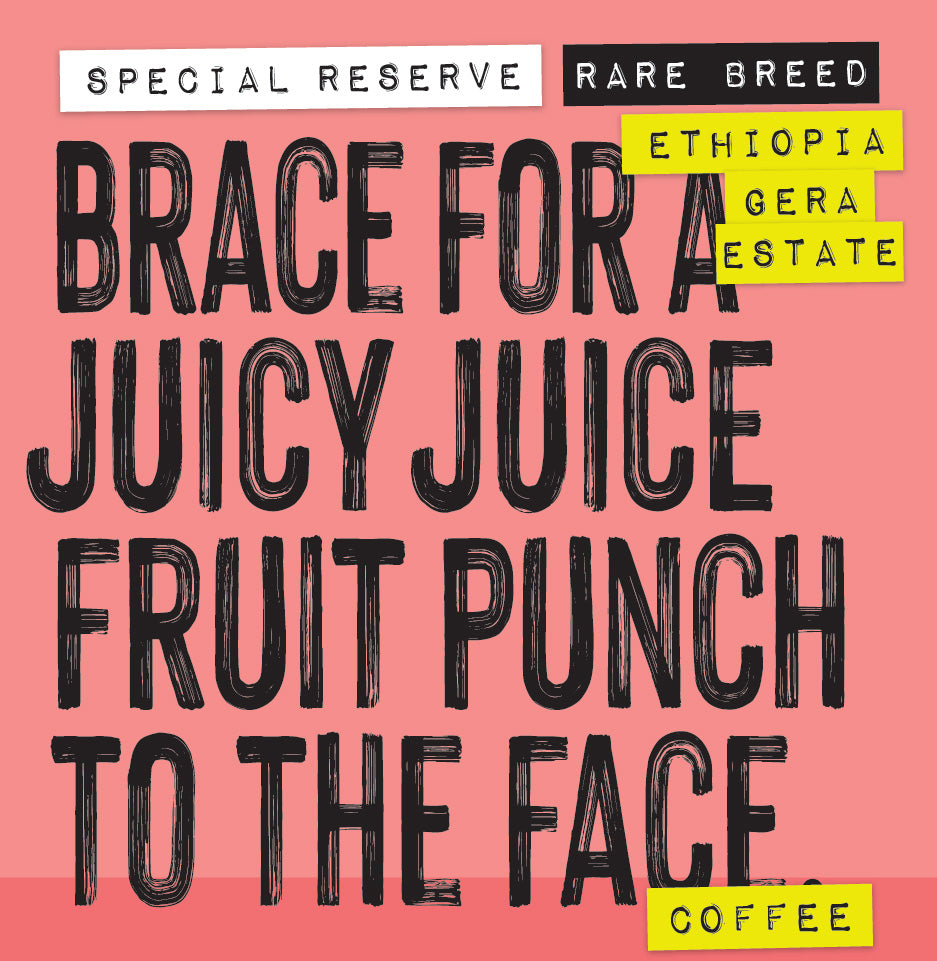Ethiopia GERE Anaerobic Fermentation Coffee
While anaerobic fermentation has been growing in popularity over the past few years, we finally found one worthy of purchasing. Take an outstanding anaerobic fermentation coffee from Ethiopia GERA estate, meticulously roast it, and you get a fruit punch to the face.
GERA Estate

The GERA Estate is situated in the Djimma region of Ethiopia, the origin of all coffee in the ancient coffee forests. GERA Estate is known for high-quality, shade-grown arabica coffee. With elevations ranging from 1880 to 2180 meters above sea level, the coffee cherries mature more slowly, allowing the natural sugars to develop.
Sustainable Farming Practices
As with any well-run company, GERA focuses on the future as well as the present. In order to preserve the land for sustainable growth and production, the estate prioritizes eco-friendly methods, avoiding chemical fertilizers and insecticides. They use nitrogen-fixing plants and natural fertilizers to nurture the coffee trees. These practices benefit the environment, as well as the employees living and working among the coffee trees.
Socially Responsible Coffee
Estates sometimes get a bad rap in the coffee community. Estates are owned by a single entity, usually a large family or corporation. They own the land, processing facilities and hire the workers. Whereas a cooperative is democratically controlled by a group of small-scale coffee farmers. Each farmer is a member with voting rights. However, there are good estates and co-ops and there are bad estates and co-ops. Gera is definitely on the good side. Along with carefully maintaining their coffee trees, they also maintain the well-being of the workers. They provide housing, childcare and education, clean drinking water, electricity, healthcare, and recreational facilities for all of its employees; free of charge.
Anaerobic Fermentation
Anaerobic fermentation is a processing method that limits the exposure to oxygen. This can be done by placing the coffee cherries in a sealed tank or by using a technique called carbonic maceration. The lack of oxygen creates an environment that favors the production of lactic acid and other compounds, contributing to the coffee's flavor profile. This anaerobic processing step shifts things just enough to introduce wild flavors. During the early years of anaerobic fermentation experimentation, the results led to rotten fruit, boozy, and moldy flavors. Even though the process is controlled, it can go awry. Off-flavors still show up with anaerobic coffees. We have tasted our fair share of these and passed on them all until along came the GERA. It has restrained fermentation, resulting in an approachable coffee with incredible complexity.
Enhanced Coffee Flavor
In addition to the sustainable practices GERA Estate implements for the land and the workers, we love the Ethiopia GERA Estate Anaerobic Fermentation coffee because of the flavor. This isn't just coffee—it's a rollercoaster ride of taste, bundling together the explosive flavors of fruit punch, the tropical tang of pineapple, the sly spice of nutmeg, and the comforting touch of hot cocoa. Add to that the teasing sweetness of brandied pears and the succulent body of juicy juice. Even if you are not a fan of natural coffees, this one is worth a try.
Roast Approach

Anaerobic fermentation is an extension of a natural process. The green coffee beans have a wider range of variance than a typical washed coffee. We roast our more delicate coffees on our Since we wanted to preserve the nuanced complexity of flavor, we roasted this coffee on the lighter side. The challenge is to drive enough heat into the beans without over developing them. If the drum charge temperature is too hot, as the beans drop in, the tips can get scorched, producing off flavors. The IR-12 allows us to roast a lighter coffee and still build body. This is because the airflow is relatively conductive on the IR-12. The sweet spot in light roasted coffees is balancing the natural acidity with sweetness. When coffee is underdeveloped, sour flavors develop in the cup as it cools. With just the right amount of development, we achieve the perfect balance between acidity, sweetness, aftertaste, flavor and body.

